Changes in Means and Extreme Events of Sea Surface Temperature in the East China Seas Based on Satellite Data from 1982 to 2017
Abstract
1. Introduction
2. Study Region, Data Source and Methods
2.1. Study Region
2.2. Data Source
2.3. Annual Frequency of Extremely Cold and Hot Days
2.4. Testing for Significance of Correlations and Trends
- (1)
- “detrend” the time series before testing for correlations between two time series and . Firstly, determining the linear fit and , and then do the hypothesis testing with and
- (2)
- “prewhiten” the time series, by first determining the sample autocorrelation of the time series of length L, and forming a series , and then testing for the null hypothesis of no trend.
3. Annual SST Changes
4. Changes in the Extreme Events and Their Relationship with Mean SST
5. Summary and Discussions
- (1)
- As a regional average, annual mean SSTA over the ECSs is subject to more notable warming trend, with a rate of 0.21 ± 0.08 °C per decade which is higher than the global mean trend based on the same data set during 1982–2017. The most significant warming was observed at the western ECS and the Bohai Sea. The warming SST during 1982–2017 is probably related to the influence from the recent strengthening and westward extension of the WPSH.
- (2)
- Our results indicate that there are significant warming tendencies in annual minimum SST and maximum SST. Compared to the rapid warming of maximum SST from the northern ECS to the Bohai Sea, the rapid warming of minimum SST mainly covers the western ECS and part of the ECS-Kuroshio. AR SST shows an out-of-phase change on both sides of 30° N during 1982–2017.
- (3)
- Rapid decreases in EHDs and increases in ECDs were detected in the ECSs from 1982 to 2017, at a rate of 15.2 days per decade and 10.5 days per decade, respectively. Spatially, the notable increases in the frequency of EHDs were observed in almost all of the ECSs, especially in the Bohai Sea and the western ECS, exceeding 20 days per decade.
Author Contributions
Funding
Conflicts of Interest
References
- Bojinski, S.; Verstraete, M.; Peterson, T.C.; Simmons, A.; Zemp, M. The concept of essential climate variables in support of climate research, applications, and policy. Bull. Am. Meteorol. Soc. 2014, 95, 1431–1443. [Google Scholar] [CrossRef]
- Giménez, L. Exploring mechanisms linking temperature increase and larval phenology: The importance of variance effects. J. Exp. Mar. Biol. Ecol. 2011, 400, 227–235. [Google Scholar] [CrossRef]
- IPCC. Climate change 2013: The physical science basis. In Contribution of Working Group I to the Fifth Assessment Report of the Intergovernmental Panel on Climate Change; Stocker, T.F., Qin, D., Plattner, G.-K., Tignor, M., Allen, S.K., Boschung, J., Nauels, A., Xia, Y., Bex, V., Midgley, P.M., Eds.; Cambridge University Press: Cambridge, UK, 2003; p. 1535. [Google Scholar]
- Belkin, I.M. Rapid warming of large marine ecosystem. Prog. Oceanogr. 2009, 81, 207–213. [Google Scholar] [CrossRef]
- Belkin, I.M.; Lee, M.-A. Long-term variability of sea surface temperature in Taiwan Strait. Clim. Chang. 2014, 124, 821–834. [Google Scholar] [CrossRef]
- Wu, L.X.; Cai, W.; Zhang, L. Enhanced warming over the global subtropical western boundary currents. Nat. Clim. Chang. 2012, 2, 161–166. [Google Scholar] [CrossRef]
- Liu, Q.Y.; Zhang, Q. Analysis on long-term change of sea surface temperature in the China Seas. J. Ocean Univ. China 2013, 12, 295–300. [Google Scholar] [CrossRef]
- Bao, B.; Ren, G.Y. Climatological characteristics and long-term change of SST over the marginal seas of China. Cont. Shelf Res. 2014, 77, 96–106. [Google Scholar] [CrossRef]
- Oliver, E.C.; Benthuysen, J.A.; Bindoff, N.L.; Hobday, A.J.; Holbrook, N.J.; Mundy, C.; Perkins-Kirkpatrick, S.E. The unprecedented 2015/16 Tasman Sea marine heatwave. Nat. Commun. 2017, 8, 16101. [Google Scholar] [CrossRef]
- Wernberg, T.; Bennett, S.; Babcock, R.C.; de Bettignies, T.; Cure, K.; Depczynski, M.; Dufois, F.; Fromont, J.; Fulton, C.J.; Hovey, R.K.; et al. Climate-drive regime shift of a temperature marine ecosystem. Science 2016, 353, 169–172. [Google Scholar] [CrossRef]
- Frölicher, T.L.; Laufkötter, C. Emerging risks from marine heat waves. Nat. Commun. 2018, 9, 650. [Google Scholar] [CrossRef]
- Cai, R.S.; Tan, H.J.; Qi, Q.H. Impacts of and adaptation to inter-decadal marine climate change in coastal China seas. Int. J. Clim. 2016, 36, 3770–3780. [Google Scholar] [CrossRef]
- State Oceanic Administration. Bulletin of Marine Disaster of China; State Oceanic Administration: Beijing, China, 2013.
- Banzon, V.; Smith, T.M.; Chin, T.M.; Liu, C.; Hankins, W. A long-term record of blended satellite and in situ sea-surface temperature for climate monitoring, modeling and environmental studies. Earth Syst. Sci. Data 2016, 8, 165–176. [Google Scholar] [CrossRef]
- Reynolds, R.W.; Smith, T.M.; Liu, C.; Chelton, D.B.; Casey, K.S.; Schlax, M.G. Daily high-resolutionblended analyses for sea surface temperature. J. Climate 2007, 20, 5473–5496. [Google Scholar] [CrossRef]
- Knapp, K.R.; Ansari, S.; Bain, C.L.; Bourassa, M.A.; Dickinson, M.J.; Funk, C.; Helms, C.N.; Hennon, C.C.; Holmes, C.D.; Huffman, G.J.; et al. Globally gridded satellite observations for climate studies. Bull. Am. Meteorol. Soc. 2011, 92, 893–907. [Google Scholar] [CrossRef]
- Lima, F.P.; Wethey, D.S. Three decades of high-resolution coastal sea surface temperatures reveal more than warming. Nat. Commun. 2012, 3, 704. [Google Scholar] [CrossRef]
- Park, K.A.; Lee, E.Y.; Chang, E.; Hong, S. Spatial and temporal variability of sea surface temperature and warming trends in the Yellow Sea. J. Mar. Syst. 2015, 143, 24–38. [Google Scholar] [CrossRef]
- Benthuysen, J.A.; Oliver, E.C.; Feng, M.; Marshall, A.G. Extreme marine warming across Tropical Australia during austral summer 2015–2016. J. Geophys. Res. 2018, 123, 1301–1326. [Google Scholar] [CrossRef]
- Liao, E.H.; Lu, F.; Yan, X.H.; Jiang, Y.; Kidwell, A.N. The coastal ocean response to the global warming acceleration and hiatus. Sci. Rep. 2015, 5, 16630. [Google Scholar] [CrossRef]
- Costoya, X.; Decastro, M.; Gómezgesteira, M.; Santos, F. Changes in sea surface temperature seasonality in the Bay of Biscay over the last decades (1982–2014). J. Mar. Syst. 2015, 150, 91–101. [Google Scholar] [CrossRef]
- Kulkarni, A.; Storch, H.V. Monte Carlo experiments on the effect of serial correlation on the Mann-Kendall-test of trends. Meteorol. Z. 1995, 4, 82–85. [Google Scholar] [CrossRef]
- Von Storch, H.; Zwiers, F.W. Statistical Analysis in Climate Research; Cambridge University Press: London, UK, 1999. [Google Scholar]
- Wolter, K.; Timlin, M.S. El Niño/Southern Oscillation behavior since 1871 as diagnosed in an extended multivariate ENSO index. Int. J. Clim. 2001, 31, 1074–1087. [Google Scholar] [CrossRef]
- Hu, S.; Fedorov, A.V. The extreme El Niño of 2015–2016 and the end of global warming hiatus. Geophys. Res. Lett. 2017, 44, 3816–3824. [Google Scholar] [CrossRef]
- Song, D.H.; Yu, H.M.; Bao, X.W. Analysis of the interannual variability of the eastern China Seas and its adjacent seas surface temperature. Period. Ocean Univ. China 2007, 37, 21–28, (In Chinese with English Abstract). [Google Scholar]
- Pei, Y.H.; Zhang, R.H.; Zhang, X.; Jiang, L.; Wei, Y. Variability of sea surface height in the South China Sea and its relationship to Pacific oscillations. Acta. Oceanol. Sin. 2015, 34, 80–92. [Google Scholar] [CrossRef]
- Zhang, Q.Y.; Tao, S.Y.; Chen, L.T. The inter-annual variability of East Asian summer monsoon and its association with pattern of general circulation over East Asia. Act. Meteorol. Sin. 2003, 61, 559–568, (In Chinese with English Abstract). [Google Scholar]
- Zhang, R.H.; Li, Q. Impact of sea temperature variability of tropical oceans on East Asian Monsoon. Meteorol. Mon. 2004, 30, 22–26, (In Chinese with English Abstract). [Google Scholar]
- Pei, Y.H.; Liu, X.H.; He, H.I. Interpreting the sea surface temperature warming trend in the Yellow Sea and East China Sea. Sci. China Earth Sci. 2017, 60, 1558–1568. [Google Scholar] [CrossRef]
- Cai, R.S.; Tan, H.J.; Kontoyiannis, H. Robust surface warming in offshore China Seas and its relationship to the East Asian Monsoon wind field and ocean forcing on interdecadal time scales. J. Clim. 2017, 30, 8987–9905. [Google Scholar] [CrossRef]
- Zhao, S.; Chang, F.M.; Li, T.G.; Zhuang, L.H.; Xiong, Z.F.; Xu, Y. Seasonal and Inter-Annual Anomalies of Sea Surface Temperature Offshore Northeastern Taiwan and Its Implication to Historical Climate Reconstructions. Earth Sci. 2018, 43, 851–861, (In Chinese with English Abstract). [Google Scholar]
- World Meteorological Organization (WMO). WMO Statement on the State of the Global Climate in 2017; World Meteorological Organization: Geneva, Switzerland, 2018; p. 35. [Google Scholar]
- Perkins, S.E.; Alexander, L.V. On the measurement of heat waves. J. Clim. 2013, 26, 4500–4517. [Google Scholar] [CrossRef]
- Perkins, S.E.; Alexander, L.V.; Nairn, J.R. Increasing frequency, intensity and duration of observed global heatwaves and warm spells. Geophys. Res. Lett. 2012, 39, 20714. [Google Scholar] [CrossRef]
- Zhou, X.Y.; Hu, D.B.; Wang, C.Z. Seasonal and interannual SST variations in the Changjiang Estuary. Period. Ocean Univ. China 2005, 35, 357–362, (In Chinese with English Abstract). [Google Scholar]
- Li, Y.; Xu, Z.L.; Gao, Q. Effects of global warming on Sagitta crassa and Sagitta enflata in the Changjiang Estuary during different years. Acta Ecol. Sin. 2009, 29, 4773–4780, (In Chinese with English Abstract). [Google Scholar]
- Ma, Z.L.; Xu, Z.L.; Zhou, J. Effect of global warming on the distribution of Lucifer intermedius and L. hanseni (Decapoda) in the Changjiang estuary. Prog. Nat. Sci. 2009, 19, 1389–1395, (In Chinese with English Abstract). [Google Scholar] [CrossRef]
- Xu, Z.L. Ecological characters of Euchaeta Concinna (Copepod) in the East China Sea. Oceanol. Limnol. Sin. 2006, 32, 97–104, (In Chinese with English Abstract). [Google Scholar]
- Liu, C. The Effect of Temperature on the Fitness Characters of Bottom Sowed Yesso Scallop; University of Chinese Academy of Sciences: Shenzhen, China, 2016. [Google Scholar]
- Medhaug, I.; Stolpe, M.B.; Fischer, E.M.; Knutti, R. Reconciling controversies about the ‘global warming hiatus’. Nature 2017, 545, 41–47. [Google Scholar] [CrossRef]
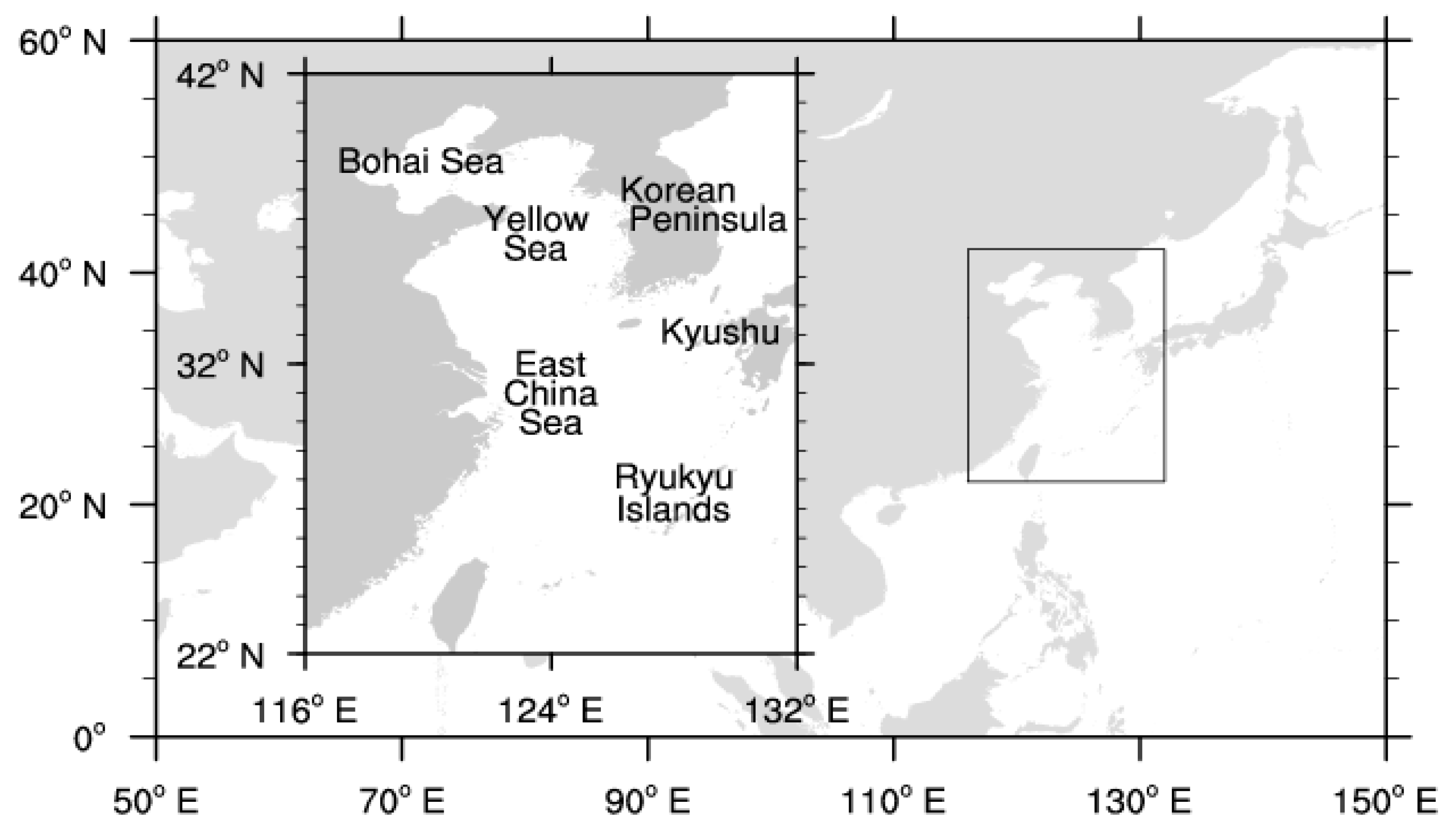
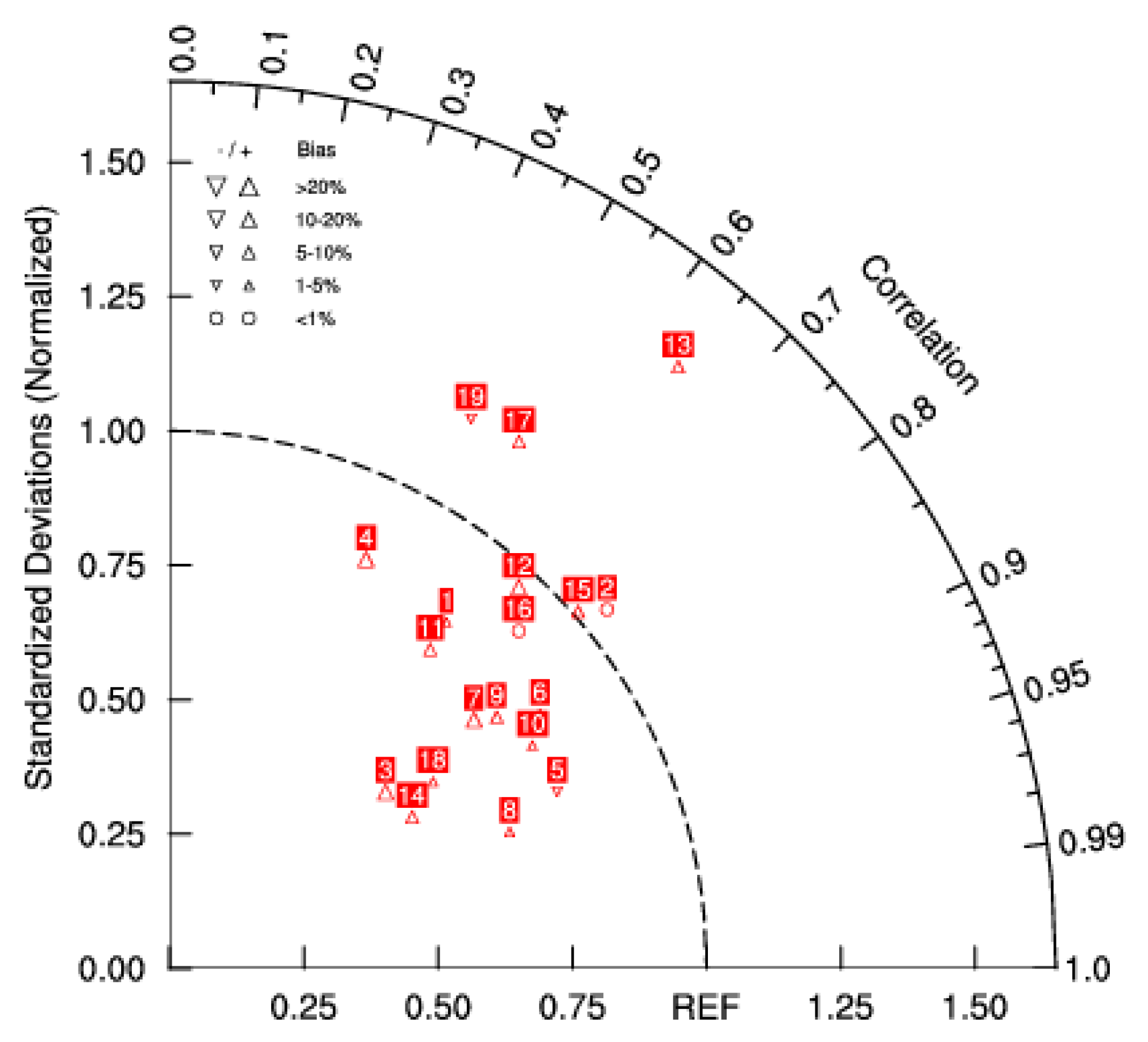
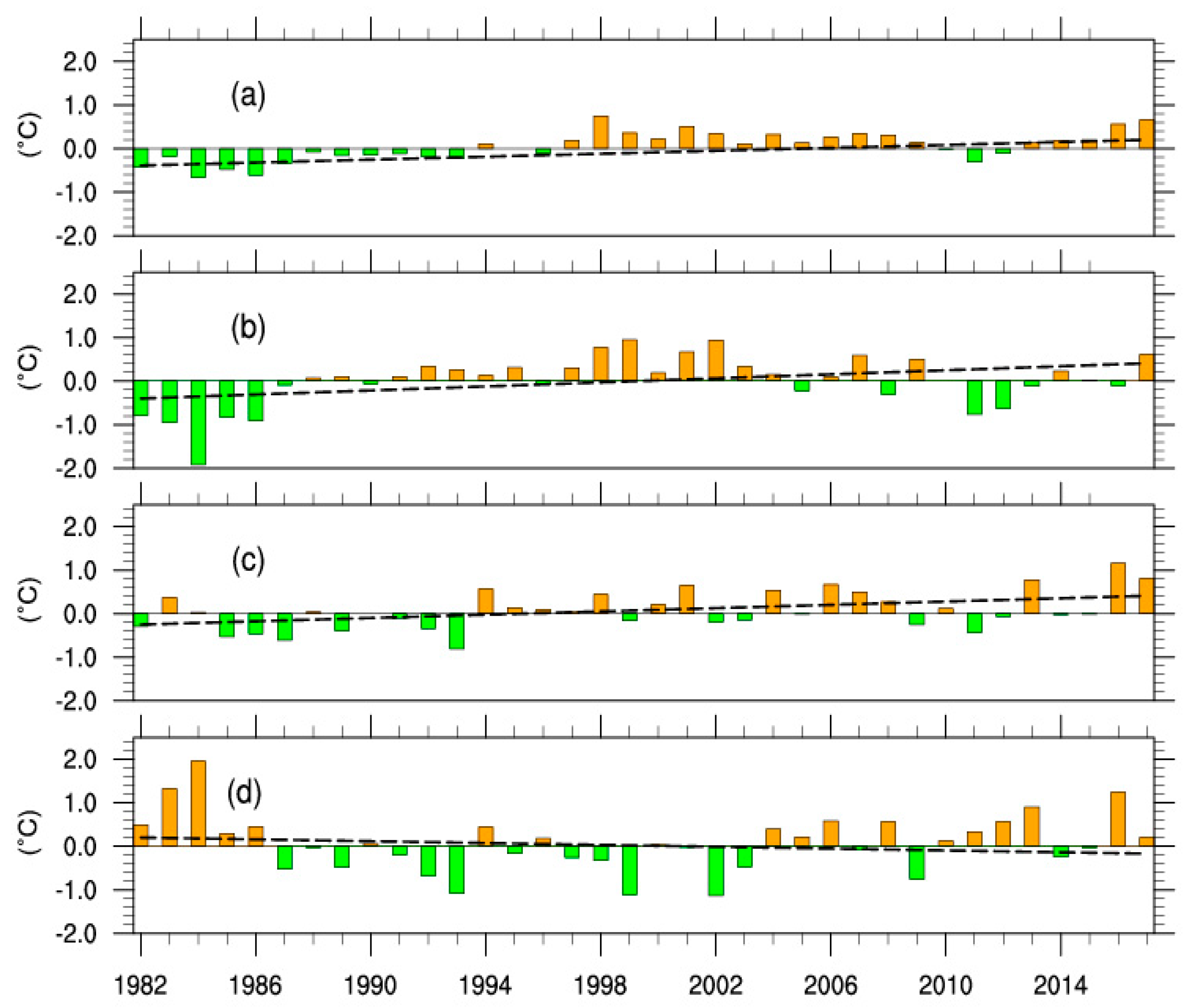
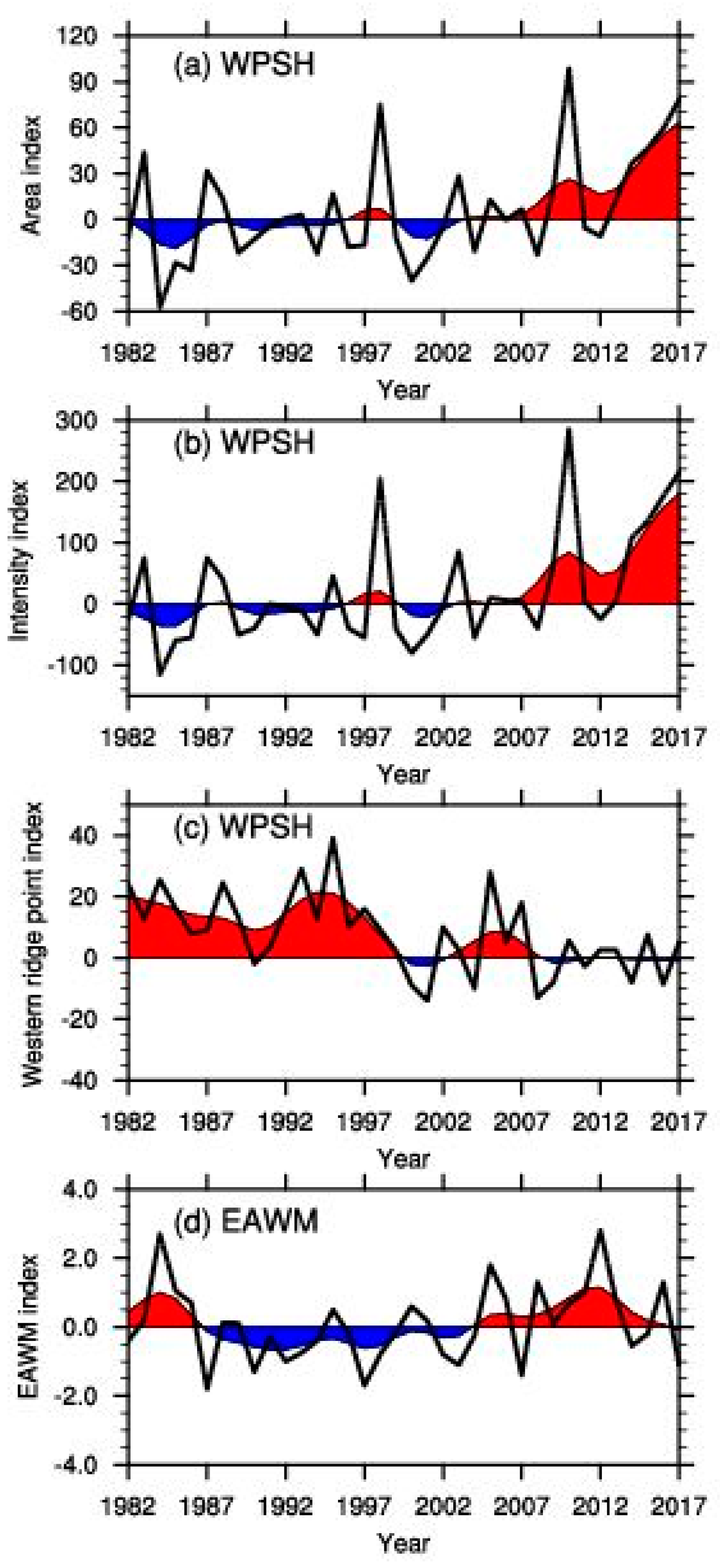
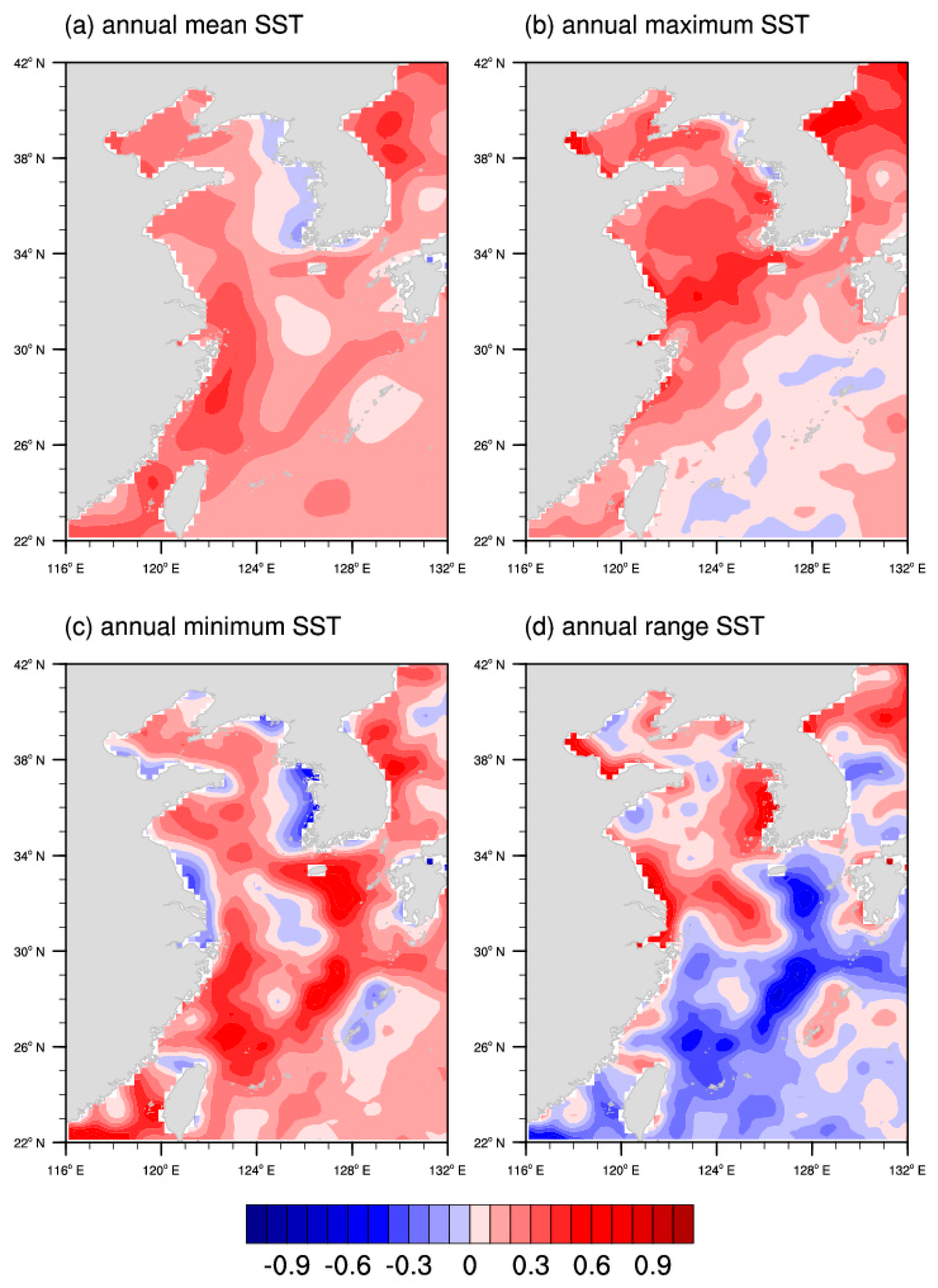
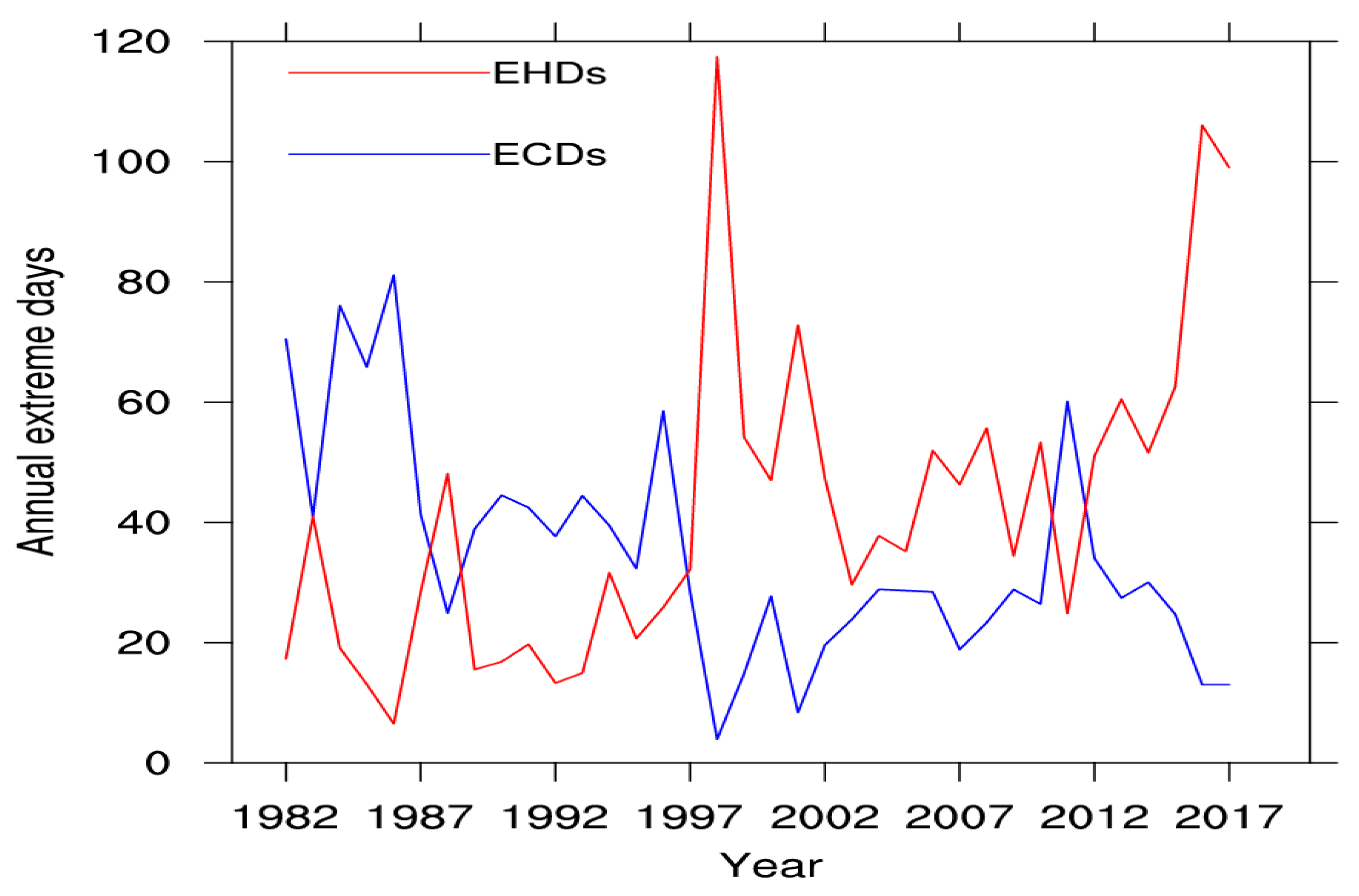
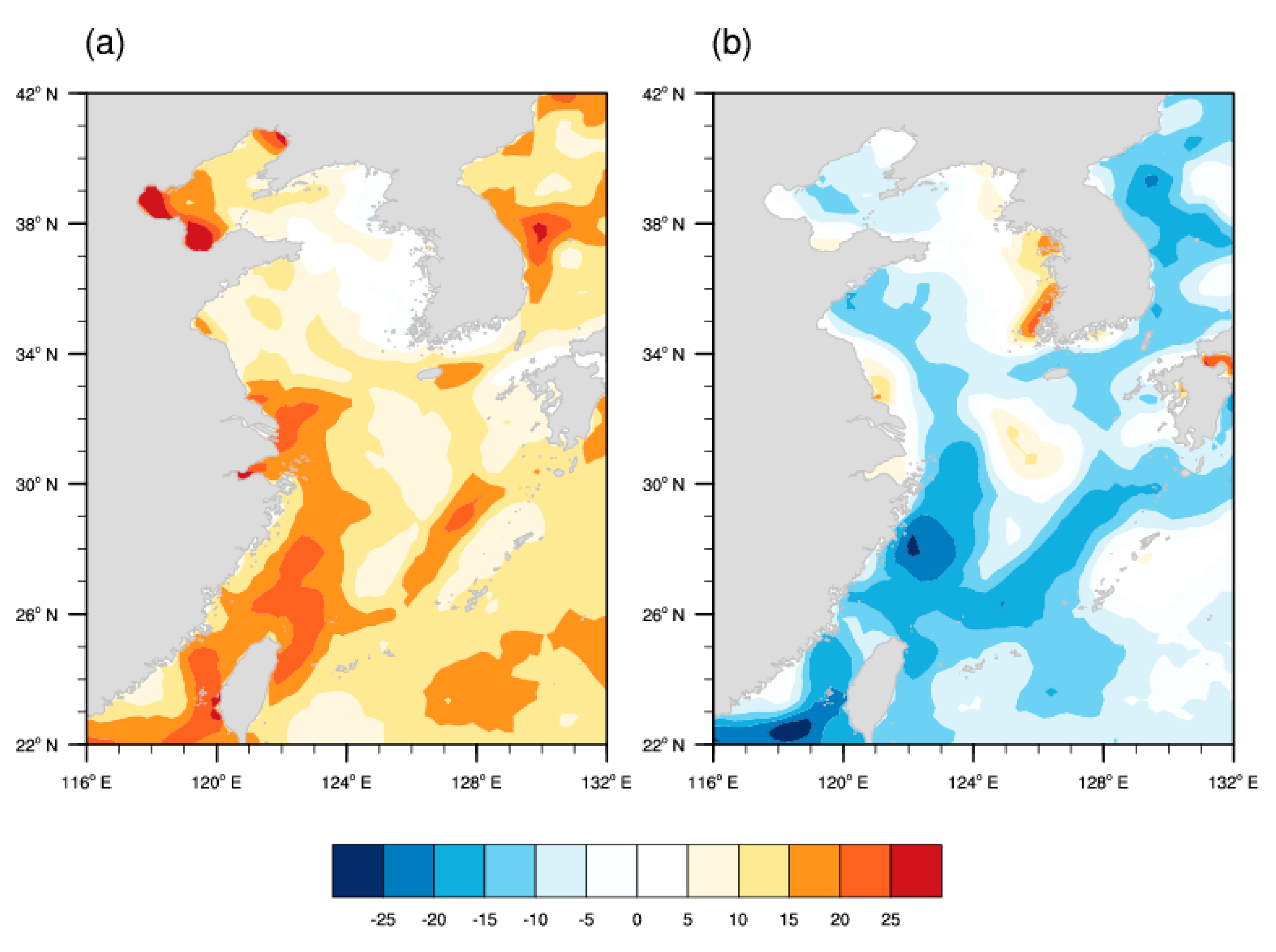
© 2019 by the authors. Licensee MDPI, Basel, Switzerland. This article is an open access article distributed under the terms and conditions of the Creative Commons Attribution (CC BY) license (http://creativecommons.org/licenses/by/4.0/).
Share and Cite
Wang, Q.; Li, Y.; Li, Q.; Liu, Y.; Wang, Y.-n. Changes in Means and Extreme Events of Sea Surface Temperature in the East China Seas Based on Satellite Data from 1982 to 2017. Atmosphere 2019, 10, 140. https://doi.org/10.3390/atmos10030140
Wang Q, Li Y, Li Q, Liu Y, Wang Y-n. Changes in Means and Extreme Events of Sea Surface Temperature in the East China Seas Based on Satellite Data from 1982 to 2017. Atmosphere. 2019; 10(3):140. https://doi.org/10.3390/atmos10030140
Chicago/Turabian StyleWang, Qingyuan, Yan Li, Qingquan Li, Yiwei Liu, and Ya-nan Wang. 2019. "Changes in Means and Extreme Events of Sea Surface Temperature in the East China Seas Based on Satellite Data from 1982 to 2017" Atmosphere 10, no. 3: 140. https://doi.org/10.3390/atmos10030140
APA StyleWang, Q., Li, Y., Li, Q., Liu, Y., & Wang, Y.-n. (2019). Changes in Means and Extreme Events of Sea Surface Temperature in the East China Seas Based on Satellite Data from 1982 to 2017. Atmosphere, 10(3), 140. https://doi.org/10.3390/atmos10030140




